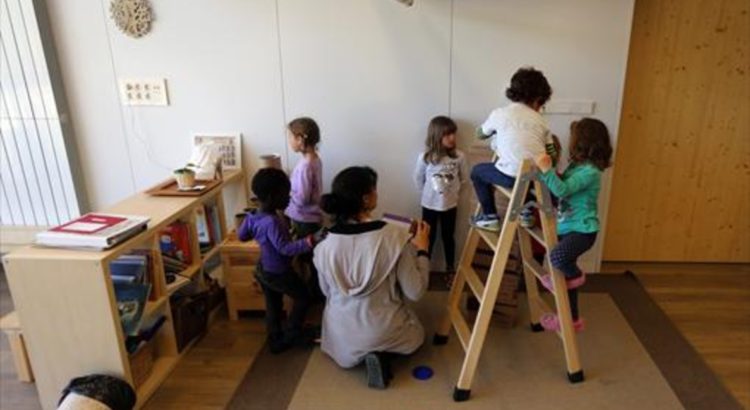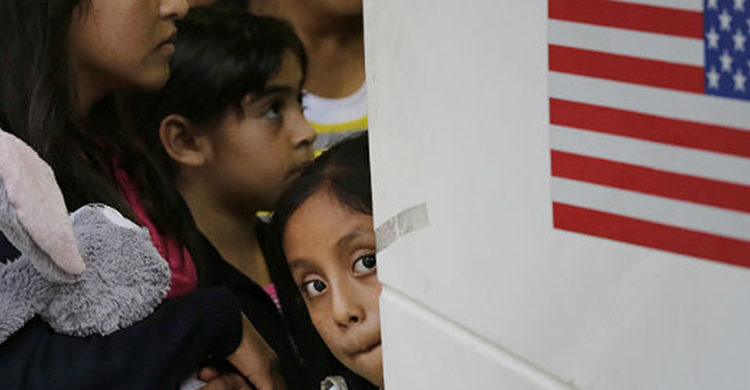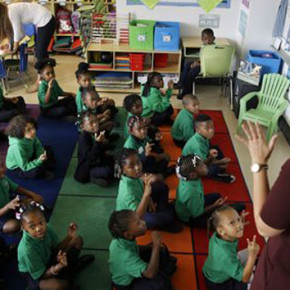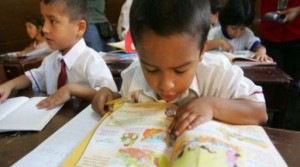América del Norte/EEUU/Abril 2016/Autor: Garance Burke and Adrian Sainz/ Fuente: Associated Press
Resumen: Associated Press ha descubierto que, en al menos 35 distritos escolares de 14 estados de los EEUU, cientos de menores, sin representantes, procedentes de El Salvador, Guatemala y Honduras, han sido disuadidos o presionado de inscribirse en las escuelas, en lo que los defensores y abogados argumentan que son diferentes pero con programas alternativos desiguales -conocidos como callejones académicos-, pudiendo violar la ley federal.
Candelario Jimon Alonzo came to the U.S. dreaming of becoming something more than what seemed possible along the rutted roads of his hometown in Guatemala’s highlands. This was his chance: He could earn a U.S. high school education and eventually become a teacher.
Instead, the 16-year-old spends most days alone in the tumbledown Memphis house where he lives with his uncle, leaving only occasionally to play soccer and pick up what English he can from his friends.
Local school officials have kept Jimon out of the classroom since he tried to enroll in January. Attorneys say Jimon and at least a dozen other migrant youth fleeing violence in Central America have been blocked from going to Memphis high schools because officials contend the teens lacked transcripts or were too old to graduate on time.
The Associated Press has found that in at least 35 districts in 14 states, hundreds of unaccompanied minors from El Salvador, Guatemala and Honduras have been discouraged from enrolling in schools or pressured into what advocates and attorneys argue are separate but unequal alternative programs – essentially an academic dead end, and one that can violate federal law.
Instead of enrolling Jimon and the other minors in high school, their cash-strapped district routed them to an adult school in East Memphis that offered English classes a few hours a week. But before Jimon could even register, the state shut the GED and English-language programs over concerns that few students were graduating, effectively ending his chances for a formal education.
«I really wanted to study math and English when I got here,» said Jimon, who grew up speaking Spanish and the indigenous language Quiche. The reed thin, soft-spoken teen is in the process of applying for permission to stay in the country permanently.
Shelby County Schools spokeswoman Natalia Powers said her sprawling district had a policy that allowed students 16 and older to choose to enroll in a GED program, and that once the program closed, students could continue studying in a «similar» program at a local nonprofit. But attorneys and advocates said their clients weren’t given the choice to attend a mainstream high school, and that the Memphis nonprofit did not teach English.
America’s schools remain one of the few government institutions where migrant youth are guaranteed services, but the federal government has extended little money or oversight to monitor whether that happens, in part because schools are locally governed.
Since fall 2013, the federal government has placed nearly 104,000 unaccompanied minors with adult sponsors in communities nationwide, where they are expected to attend school while they seek legal status in immigration court. Months later, during the dramatic surge of illegal crossings at the border, the Education and Justice departments issued joint guidance reminding districts that a 1982 Supreme Court ruling established that states cannot deny children a free public education, regardless of immigration status.
Districts found to have broken the law can be forced to change their enrollment policies, but making that happen is not easy. To start, few migrant children understand their rights.
Students and their advocates can sue districts or file complaints with the Education or Justice departments, but investigations are so backlogged that decisions can take years and typically result only in civil sanctions, said Lisa Carmona, a senior attorney with the nonprofit Southern Poverty Law Center.
«Some students who come from other countries may be far behind, but that doesn’t allow the school district to say that you will never succeed so we will put you in our least challenging environment, forever,» said John Affeldt, managing attorney with San Francisco-based civil rights nonprofit Public Advocates. «You won’t see that challenged very often because these kids usually aren’t connected to communities that have a lot of resources or access to lawyers.» Many local school districts have stretched to find the resources and staff to meet the educational needs of these students, who often carry emotional trauma, have gaps in their education and are older than other English-language learners.
To determine where that was not happening, the AP analyzed federal data to identify areas where the number of migrant children was relatively large when compared to public school enrollment, along with the number of students formally learning English. In Alabama, California, Florida, Louisiana, Maryland, Massachusetts, Mississippi, New Jersey, New York, North Carolina, Ohio, Tennessee, Texas and South Carolina, social workers and attorneys told AP that migrant students have been barred from enrolling, kept out of class for months due to elaborate paperwork requirements or routed to reform schools and adult programs. The full extent of how the Central American minors are faring in schools is unknown because the government does not release data on counties where fewer than 50 minors have been placed, which means information was not provided for about 25,000 of the migrants. Some examples of where AP found unaccompanied youths facing educational barriers:
-Case managers said schools in Florida’s Miami-Dade County had routed teens as young as 16 to adult schools, where they can take only English as a Second Language classes. Miami-Dade County Public Schools spokesman John Schuster said registration in the adult program was optional, and could include GED prep.
-City officials in Lynn, Massachusetts, suggested two Central American teens were lying about their age to get into high school in summer 2014. Since then, dozens of unaccompanied minors have been sent to alternative newcomers programs, where they studied English and other material but received no credit. The district declined comment.
– About 50 unaccompanied minors were denied access or routed into alternative, non-degree bearing programs in Hempstead and Westbury, on New York’s Long Island. A settlement was announced in March requiring the Westbury district to improve enrollment policies and provide students comprehensive instruction.
Spokeswomen for the Education and Justice departments declined to comment on the scope of the problem, but said the agencies remained vigilant about protecting unaccompanied migrant students’ civil rights.
Some districts have gone to extraordinary lengths to accommodate the students, who often come to join relatives, sometimes escaping criminal gangs or extreme poverty. One district in rural Kansas rerouted a school bus to ensure a group of unaccompanied teens could make it to class. A San Francisco high school rewrote young-adult novels at a basic level to spark the newcomers’ interest in reading. A Maryland district created a new after-school program to help students bond with their sponsors.
In Rhode Island, a handful of small school districts have dragged their feet in registering migrant children, but two diverse urban districts – Providence and Central Falls – have welcomed the challenging population. At Providence’s Mt. Pleasant High School, teacher Murkje Dekoe said her Central American students who work weekends in cranberry bogs and late nights in jewelry factories have the highest attendance rates.
In March 2015, federal officials made $14 million in grants available for county school districts where the government placed more than 50 unaccompanied minors with sponsors. But that amounts to less than $175 for each unaccompanied child placed in those counties in the last two and a half years, which many districts say leaves them to cover too much of the cost.
In Florida’s Miami-Dade, the country’s fourth-largest school district, officials estimate it costs about $2,700 more per year to educate each foreign-born student.
«When refugee kids are resettled, it is a policy decision that gets made and arrives at our door,» said Gabriela Uro, a director at the Council of the Great City Schools, which represents large, urban districts, including Miami.
«We have basically had to help each other because we have not been getting much in the way of help from the states or the feds,» she said.
The new student population can have a particularly noticeable impact in smaller districts, such as the 3,000 pupil district in Nobles County, Minnesota, about 250 miles southwest of Minneapolis. Since fall 2013, the government has placed at least 121 unaccompanied minors there, equivalent to about 3 percent of current public school enrollment, according to federal data.
The district hired two new English-language instructors and some special education support staff in the last year to meet the students’ needs.
«We evaluate them related to their abilities with language and grade level so we can provide interventions,» said Worthington school district Superintendent John Landgaard. «There is no one-size-fits-all box for these kids.»
All children must attend school until at least the eighth grade or until they turn 16 under compulsory education laws in all 50 states. Students can enroll beyond that age in many states.
For students learning English, federal guidance says school districts must provide appropriate language assistance services so students can participate equally in the standard instructional program within a reasonable period of time.
In the heart of Silicon Valley – near the headquarters of Facebook, where CEO Mark Zuckerberg often calls for immigration reform – attorneys said two wealthy California districts have shunted off about 30 migrant teens to adult schools.
On a recent morning, about a dozen Central American youths were studying ESL in trailer classrooms; they said the San Mateo Union High School District blocked them from going to the high-performing high school next door.
«We tried to go to the high school because the classes are a lot more interesting there, but they said we couldn’t,» said Melvin Lara, 18, who recently arrived from El Salvador and had hoped to study at San Mateo High School, which Newsweek deemed one of America’s top high schools.
District spokeswoman Sheri Costa-Batis said only teens who were at least 17 1/2 years old and arrived at the district «significantly undereducated» are referred to San Mateo Adult School for «intensive learning.» She also said that students must go through a waiver process and get a release from their parent or guardian in order to attend.
Even in states like New York, where many districts already had special curriculum for immigrant students, some newcomer programs have been criticized for failing to bring English learners into the mainstream.
Since January 2015, 22 New York districts have changed their policies as the result of an ongoing investigation by the state attorney general into claims that school officials routed immigrant students into alternative, non-degree bearing programs or denied them access.
Neither the Education Department nor Justice Department would say how many of the nation’s roughly 14,000 school districts have been investigated for similar failures.
Education spokeswoman Dorie Nolt said her department has given districts extensive resources to access relevant federal services and supports.
«We remain committed to working with federal partners and community-based organizations to address any issues that unaccompanied children, their sponsors, and families may face in dealing with the education system,» she said.
Fuente de la noticia: http://readersupportednews.org/news-section2/318-66/36640-migrant-children-kept-from-enrolling-in-school
Fuente de la imagen: http://readersupportednews.org/images/stories/article_imgs20/020871-school-children-migration-050216.jpg














 Users Today : 24
Users Today : 24 Total Users : 35460233
Total Users : 35460233 Views Today : 29
Views Today : 29 Total views : 3418924
Total views : 3418924